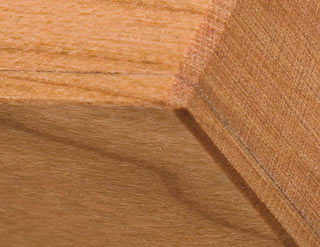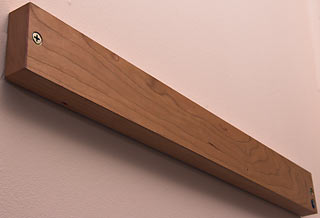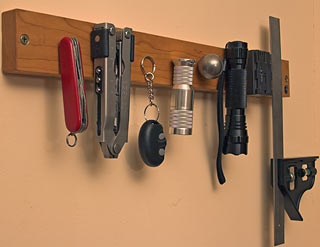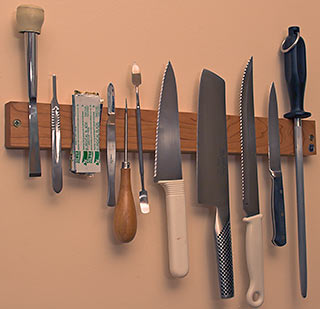
Mag-Blok magnetic holder
Review date: 27 January 2008 Last modified 09-May-2012.
The magnetic knife holder is a simple enough concept. It has several advantages over an ordinary slotted knife block.
A magnetic holder can hold any shape or size of knife, for instance. And it can also hold other things, like chisels or keys, or anything else that's ferromagnetic and not too heavy.
Gunk can collect in the slots of a normal knife block, and contaminate your knives; not so with a magnetic holder. And moisture hangs around in knife block slots, too. If you put a damp carbon-steel knife into a wooden block, it'll stay wet, and rust. On a magnetic rack, it'll air-dry.
Plus, all those bare blades hanging on the wall look cool.
Simple magnetic tool holders, however, also have their problems.
They're usually based around a couple of strips of rubbery fridge-magnet material, with steel rails on either side of each strip, to concentrate the magnetic field and increase the chance that things will stay stuck. Or they have ordinary ferrite magnets, with some similar sort of field-concentrating gizmo.
This sort of setup works passably well and is cheap to make, but it doesn't give a lot of field strength, so you'd better not be hanging anything very heavy from a cheap magnetic strip. And the bare-metal field concentrators can chip knife edges. And cheap magnetic strips look like cheap magnetic strips. One can hardly hang $2000 worth of exquisite drop-forged blades from a $5 piece of plastic, dahlink.
For years, though, there was no practical alternative to the cheap kind of magnetic strip, essentially because no better magnets were available. Samarium-cobalt magnets have been around since the '70s and are much stronger than ferrites, but they're also very expensive.
Nowadays, though, the magnet market is saturated with cheap neodymium-iron-boron ("NIB") magnets, about which I've written on a number of previous occasions.
NIB magnets are even stronger than samarium-cobalt, and large ones - as in, magnets big enough that if you handle them even slightly carelessly they'll smash your hands like a sledgehammer - are quite affordable.
Large magnets, in essence, give you a large magnetic field, without any field-concentrating jiggery-pokery. A line of good-sized NIB magnets have so large a field that you could embed them in, I don't know, a block of wood, and still have a very useful amount of field strength on the outside of it.
Which is why this exists.
It's called the Mag-Blok, and it's made by a company called Benchcrafted.
At a glance, the Mag-Blok just looks like a piece of wood with a light satiny finish (which is, yes, food-safe), with brass-inlaid countersunk mounting holes at either end.
Look closer, and you can see the seam where the original piece of wood was cut open, so that a row of hefty NIB magnets could be interred within it.
This Mag-Blok is the eighteen-inch cherry-wood model, yours for a mere $US35 plus delivery. You can get Mag-Bloks made from a variety of other woods, plus smaller 12-inch versions as well. You can also order custom outsized models or versions in whatever exotic wood takes your fancy, though those cost considerably more.
A bit of fishing reveals that this eighteen-inch model contains nine distinct magnetic regions, which according to Benchcrafted are made up of 21 individual magnets. The north and south poles of the regions alternate. This means there are slight dead spots between the magnets - stick a small object to the Blok and it'll tend to hop to the middle of the nearest field region - but it also gives more holding power close to the Blok, at the price of reducing the total size of the Blok's magnetic field.
This is actually the way you want a magnetic tool-holding thingy to behave - lots of sticking power close to it, but no huge field hanging around in front of it to wipe your credit cards. Fridge magnets are set up the same way; their apparently homogenous surface is actually a series of rows of north and south poles, as you can quickly discover if you rub two of them against each other.
The back side of the Mag-Blok, by the way, either includes an iron sheet that shortens the magnetic circuit, preventing the Blok from having much of a field behind it at all, or the magnets are arranged in a Halbach array, which has the same effect. This is another desirable feature, unless you want to be able to store your paper clips on the other side of the wall on which a Mag-Blok is mounted.
Installing the Mag-Blok is no harder than screwing anything else to your wall. If you've got a masonry wall then you'll need a hammer-drill and wall plugs; if you've got a standard hollow gypsum-board wall like the one I chose for my Blok, you'll need some other kind of anchor.
Ideally, at least one end of the Blok should be fixed to a wall stud, but none lined up right for the mounting spot I chose, so I winged it with a couple of those giant-screw-type plastic anchors. If you don't intend to hang very heavy things off your Mag-Blok, you don't of course need to attach it to your wall as if it were a stressed component of a major road bridge.
It's surprising how much stuff you can hang off one of these things, though.
Three of these tools starred in a related picture in my first magnets piece.
Realistically, it's not practical to hang stuff quite this huge from a Mag-Blok. It wouldn't be hard to knock such bulky objects off the Blok, and then you'd have two kilos of C-clamp headed for your foot.
(If you want to store hefty tools on Mag-Bloks, Benchcrafted recommend you buy your Bloks in pairs, and mount them one above the other.)
But, for what it's worth, even with just the one Blok, none of the stuff in the above picture is only barely hanging on.
A slightly more realistic selection of magnetic objects.
Pocket-knives, multitools and sets of keys are, of course, perfectly suited to Mag-Blok storage.
The square on the end in the above picture is the sort of tool that's, in one sense, perfectly suited to this sort of storage. It's a quite lightweight slab of steel that sticks beautifully to the Blok. But in another sense, it's entirely unsuitable - you probably don't want to magnetise tools that you'll be using near metal shavings, because then the shavings will stick to the tool and annoy you.
The flashlights in the above picture (reviewed here and here) are made from aluminium; only the steel cases of the batteries inside are keeping them stuck to the Mag-Blok. But the flashlights aren't heavy, either, so they hang on there pretty well.
The grey object on the far side of the black flashlight is a camera battery. It, too, sticks because of the steel in the cells inside its non-magnetic casing.
The random spherical object is just a steel ball. It hangs onto the Mag-Blok real good.
The original purpose of the Mag-Blok is knife storage, and it works very well for that, too.
Ah, you're awake.
Now we can begin the procedure.
Overall
The Mag-Blok does what it says on the tin.
(Except it doesn't actually come in a tin, or even a box - its packaging is a natty see-through plastic tube, with two brass mounting screws in the cap.)
If you're looking for an elegant magnetic rack for kitchen knives, or any other items that (a) are ferromagnetic and (b) will still function after you stick 'em to a magnet, then this is the rack you're looking for.
I'd qualify this recommendation if the Mag-Blok weren't very powerful, or if it were very expensive.
But it's strong enough that I found it was possible to (somewhat precariously) stick a 425-gram (15-ounce) can of tuna to it.
And models like the one I got for review only cost $US42 including delivery, for US customers.
You do have to find some way to firmly affix the Blok to your wall, so this is probably not a product for people in rental accommodation.
But for everyone else, the Mag-Blok gets a Recommended from me.
Review Mag-Blok kindly provided by Benchcrafted.








